|
3 Major
Themes in Modernism
A.
Move
away from representing social conditions (realism) to
representing feeling
B.
Aesthetic concerns: shape, pattern, color
C.
L’art
pour l’art:
art for art’s sake
|
|
Move toward Modernism
|
|
I.
Artistic Movements
A.
Symbolism
B. Impressionism
C.
Art
Nouveau
II.
Influences of Modernism
A.
Photography
B.
Japanese
Woodblock Prints
C.
Philosophy: Nietzsche
III. Elements of Modernism
A.
Abstraction
B.
Primitivism
C.
Experimentation with time and space
D.
The
unconscious |
|
I. Artistic Movements |
|
A.
Symbolism |
|
A.
Literature:
Mallarmé, “The Afternoon of a Faun” (1877)
B.
Stream
of sensations merging past and present
C.
Music:
Debussy, Prelude to “The Afternoon of a Faun” (1894)
YouTube - Debussy: L'après-midi d'un faune (Stokowski) part
1/2
YouTube
- Rudolf Nureyev dança "L'Après-midi d'un Faune", de Debussy
D.
Painting:
1.
“simplification of line”
2.
“arbitrary color”
3.
“expressive, flattened form” (Fiero)
|
|
Swiss Painter:
Ferdinand Hodler (1852-1918)
|
|

Source:
Hodler, “The Chosen One.” 1893-94. Acropolisinc. Web.
27 Sep 2011.
http://cgfa.acropolisinc.com/h/p-hodler1.htm

Source:
Hodler, “Tired of Life.” 1892. Wikigallery. Web. 27
Aug 2011.
http://www.wikigallery.org/wiki/painting_238383/Ferdinand-Hodler/Tired-of-Life
 |
|
B. Impressionism
|
|
A.
Form becomes color;
colors placed side by side, not blended
B.
Painting in open air
with new synthetic paints
C.
Focus on how one
sees more than what one sees: scientific
1.
Chevreul, The
Principles of Harmony and the Contrast of Colors
2.
von Helmholtz, studies
of relationship between musical tone and color
D.
Ultra-realist, but
moves toward abstraction
E.
Focus on modern,
middle-class life; urban, suburban
|


(left) Source:
Monet, “Impression: Sunrise.” 1873. Archive. Web. 27
Aug 2011.
http://www.artchive.com/artchive/M/monet/sunrise.jpg.html
(right) Source:
Monet, Water-Lily Pond, “Symphony in Green (Japanese
Bridge).” 1899. Claude-monet. Web. 27 Aug 2011.
http://claude-monet.org/artbase/Monet/1899-1899/w1515/apc.jpg
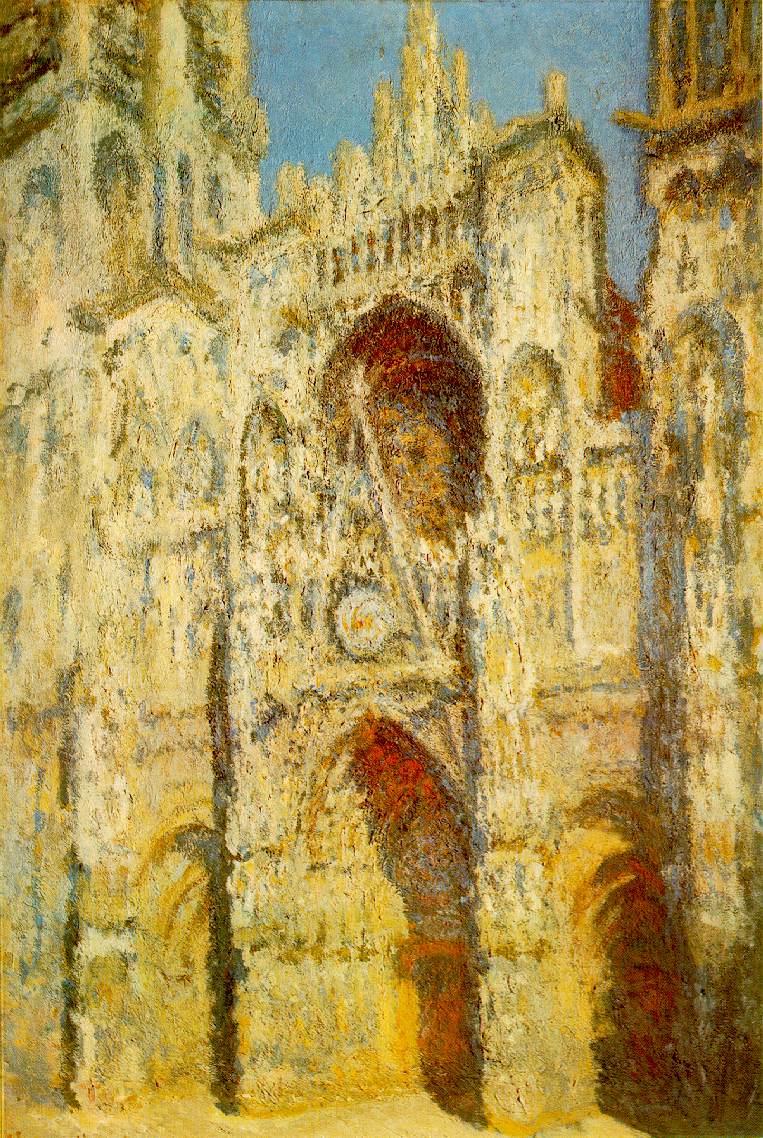
Source:
Monet, “Rouen Cathedral.”1893. Secred-destinations. Web.
27 July 2011.
http://www.sacred-destinations.com/france/rouen-cathedral
|


(left) Source:
Renoir, “Le Moulin de la Galette.” 1876. Ibiblio. Web.
29 Aug 2011.
http://www.ibiblio.org/wm/paint/auth/renoir/moulin-galette/renoir.moulin-galette.jpg
(right) Source:
Pissarro, Boulevard Montmartre: “Rainy Weather, Afternoon.”
1897. Archive. Web. 27 July 2011.http://www.artchive.com/artchive/P/pissarro/montmartre_rainy.jpg.html
|


(left) Source:
Caillebotte, “Paris Street; Rainy Day.” 1877. Artic. Web.
29 July 2011.
http://www.artic.edu/artaccess/AA_Impressionist/pages/IMP_4_lg.shtml
(right)
Source: Cassatt, “The
Boating Party.” 1893-94. Tumblr. Web. 27 July 2011.
http://cavetocanvas.tumblr.com/post/7668852375/the-boating-party-mary-cassatt-1893-94
|
|
Katsushika Hokusai
(1760-1849)
|

Source:
Katsushika Hokusai, “Mount Fuji Seen Below Wave at Kanagawa”
ca. 1830. Artfund. Web. 27 July 2011.
|
|
Edgar Degas (1834-1917)
|
|

Source:
Degas, “Before the Ballet.” 1890-92. Artgalleryabc. Web.
27 July 2011.
http://www.artgalleryabc.com/degas/blog

Source: Degas, “The
False Start.” 1870. Impressionistsgallery. Web. 27
July 2011.
http://www.impressionistsgallery.co.uk/artists/Artists/def/Degas/pictures/18a.jpg
|
|
Mary Cassatt (1844-1926) |


(left) Source:
Cassatt, “The Bath.” 1892-92. Hosstuffworks. Web.
27 July 2011.
http://entertainment.howstuffworks.com/arts/artwork/paintings-by-mary-cassatt6.htm
(right)
Source: Cassatt, “The Letter.”
1890-91. A1reproductions. Web. 27 July 2011.
http://a1reproductions.com/the-letter-1890-91-by-mary-cassatt-oil-painting.html

Source:
Cassatt, “Portrait of a Little Girl.” 1878. Wikipaintings.
Web. 27 July 2011.
http://www.wikipaintings.org/en/mary-cassatt/little-girl-in-a-blue-armchair-1878
 |
|
C. Art Nouveau
|
|
A.
Ornamental style
extremely popular in 1890s & early 1900s—a popular modernism
B.
Founded by Victor Horta
of Belgium
C.
Serpentine lines,
organic forms
D.
Modern industrial
materials (iron, glass)—influence of Eiffel Tower (material
and style)
E.
Influenced by Asian &
Islamic art
Often featured women with luxuriant hair, seducing or
enchanting |
|
Alphonse Mucha (1860-1939) |


(left) Source:
Mucha, “Dance.” 1898. Blogspot. Web. 27 July 2011.
http://thedelightsofseeing.blogspot.com/2011/02/art-nouveau.html
(right)
Source:
Mucha, “Job.” 1896. Blogspot. Web. 27 July 2011.
http://thedelightsofseeing.blogspot.com/2011/02/art-nouveau.html
|
|
Victor Horta (1861-1947) |
|

Source: Horta,
“Stairway.” 1892-93. Avenuedsterio. Web. 27 July
2011.
http://www.avenuedstereo.com/modern/horta_tassel.jpg
|
|
Auguste Rodin (1840-1917) |
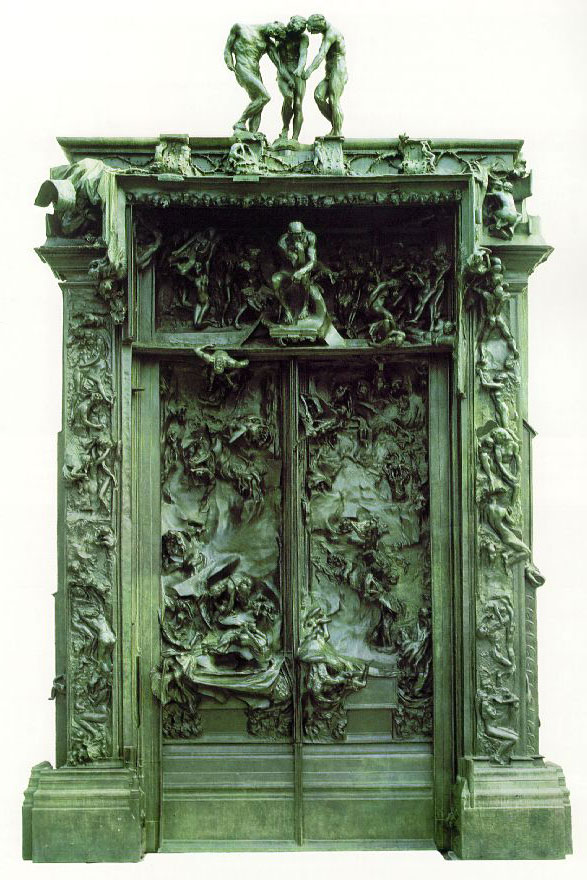
Source: Rodin, “Gates of Hell.”1880-1917. Ibiblio. Web.
27 July 2011.
http://www.ibiblio.org/wm/paint/auth/rodin/

Source: Rodin, “The Thinker.” 1880.
Artchive. Web. 27 July 2011.
http://www.artchive.com/artchive/R/rodin/thinker.jpg.html
 |
|
II.
Influences of
Modernism |
|
A.
Photography
|
|


Sources:
Motion Study: Thomas Eakins nude, running to left, ca. 1885,
Pennsylvania Academy of the Fine Arts
http://www.pbs.org/eakins/img_1882.htm
Thomas Eakins, "MOTION STUDY: male nude,
standing jump to right",
http://www.whyy.org/about/pressroom/8.jpg |
|
B.
Japanese Woodblock Prints |
|
1.
Imported to West beginning in 1860s
2.
Flat colors, curving lines
3.
“Empty” space
4.
Unique perspectives; bold contrasts; discontinuities
between near and far
5.
Everyday life & landscapes
6.
Theodore Duret: “Before Japan . . . the painter always lied”
(790)
|
|
C. Philosophy: Nietzsche (1844-1900)
|
|
A.
“God is dead. God
remains dead. And we have killed him” (in Fiero)
B.
A critic of democracy:
democracy=mediocrity
C.
Critic of the idea of
“progress”
D.
Celebrates the
“superman” who rises above traditional morality
E.
Celebrates the
“Dionysian” (irrational) over the “Apollonian” (rational)
spirit in the Western tradition
 |
|
III. Elements of
Modernism
|
|
A.
Abstraction
B.
Primitivism
C.
Experimentation with
time and space
D.
The Unconscious
|
|
A. Abstraction in
Painting |
|
Abstraction:
nonrepresentational art: self-consciousness of medium: art
for art’s sake
Maurice Denis painting is “a float surface with shapes,
lines and colors assembled in particular order.” |
|
Paul Cézanne (1839-1906) |
|

Source:
Cezanne, “The Basket of Apples.” C. 1895. Britannica.
Web. 27 July 2011.
http://www.britannica.com/EBchecked/media/19596/The-Basket-of-Apples-oil-on-canvas-by-Paul-Cezanne
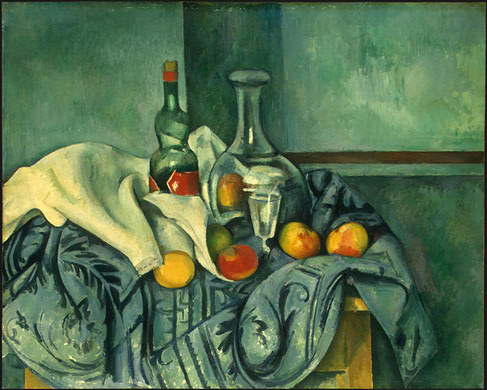
Source: Cezanne,
“Still Life with Peppermint Bottle.” c.1894. Chisnell.
Web. 27 July 2011.
http://chisnell.com/art/PostImpressionism/Forms/Gallery.aspx

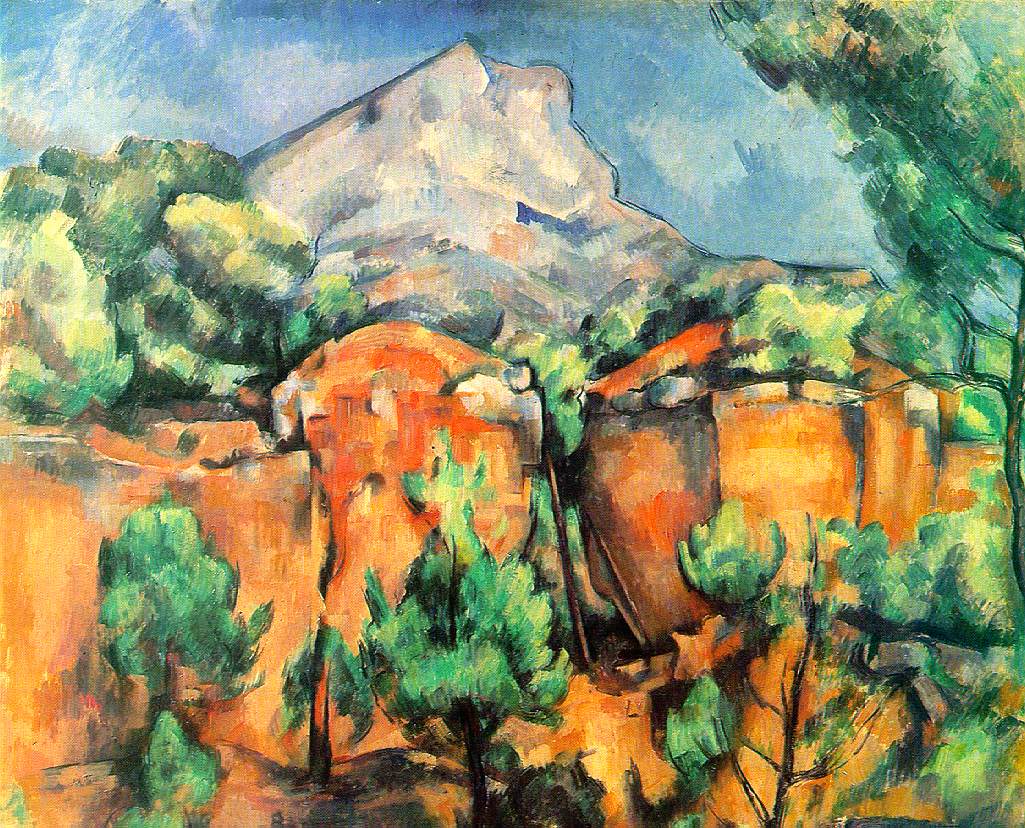
(left) Source: Cezanne, “Mount Sainte-Victoire
Seen from Bellevue. c. 1882-85. Baymaugallery. Web.
27 July 2011.
https://sites.google.com/site/baymaugallery/gallery9
(right) Source:
Cezanne, “Mont Sainte-Victoire Seen from the Bibemus
Quarry.” c. 1897. Baymaugallery. Web. 27 July 2011.
https://sites.google.com/site/baymaugallery/gallery9
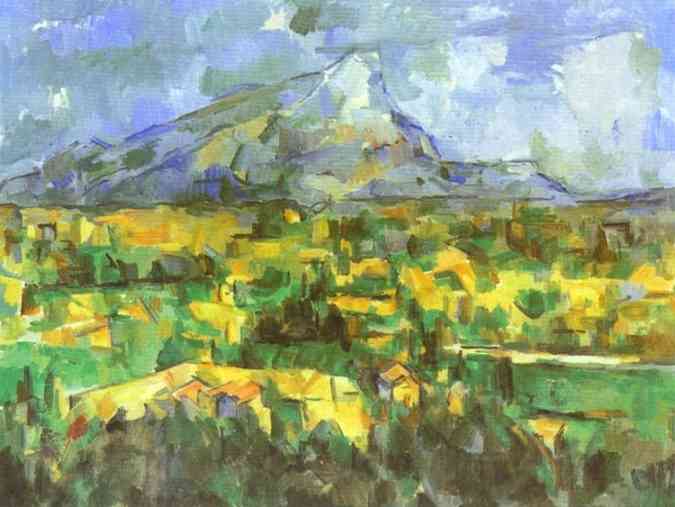
Source:
Cezanne, “Mount Sainte-Victoire.” 1904-1906.
Baymaugallery. Web. 27 July 2011.
https://sites.google.com/site/baymaugallery/gallery9
|
|
B. Primitivism
|
|
A.
Modernist influenced by
traditional cultures of Africa and Oceania (Gaugin, Picasso,
etc.)
B.
Background: 1889 Paris
Exposition Universelle: showed arts of Asia, Africa and
Oceania.
C.
Rise of anthropology:
Sir James Frazer, The Golden Bough, a comparative
study of traditional
flock customs.
D.
Modernist interest in
primitive cultures arose from contact with those cultures.
E.
Ironically, this
contact contributed to the destruction of those cultures.
Modernist primitivism is therefore nostalgic. |
|
Paul Gauguin (1848-1903) |
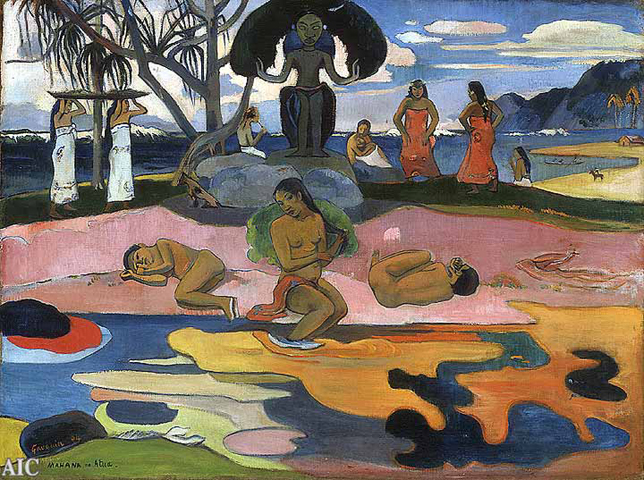
Source:
Gauguin, “Day of the Gods (Mahana No Atua).” 1894. Artic.
Web. 27 July 2011.
http://www.artic.edu/artaccess/AA_Impressionist/pages/IMP_9_lg.shtml
 |
|
Work Cited
|
|
Fiero, Gloria. The Humanistic Tradition. Vol. 2. 6th
ed. New York: McGraw-Hill, 2011. |